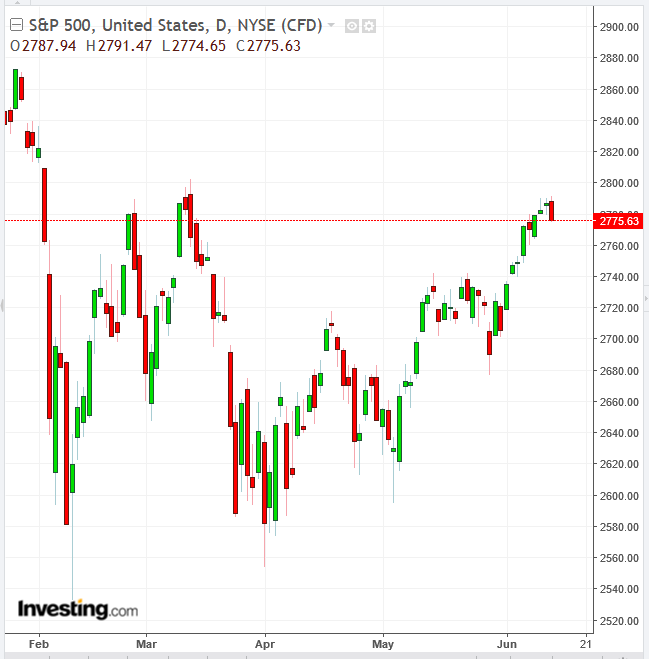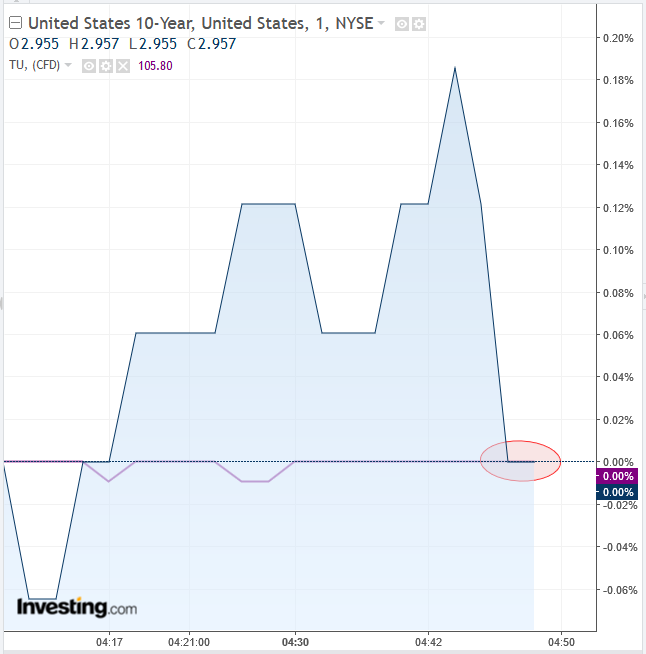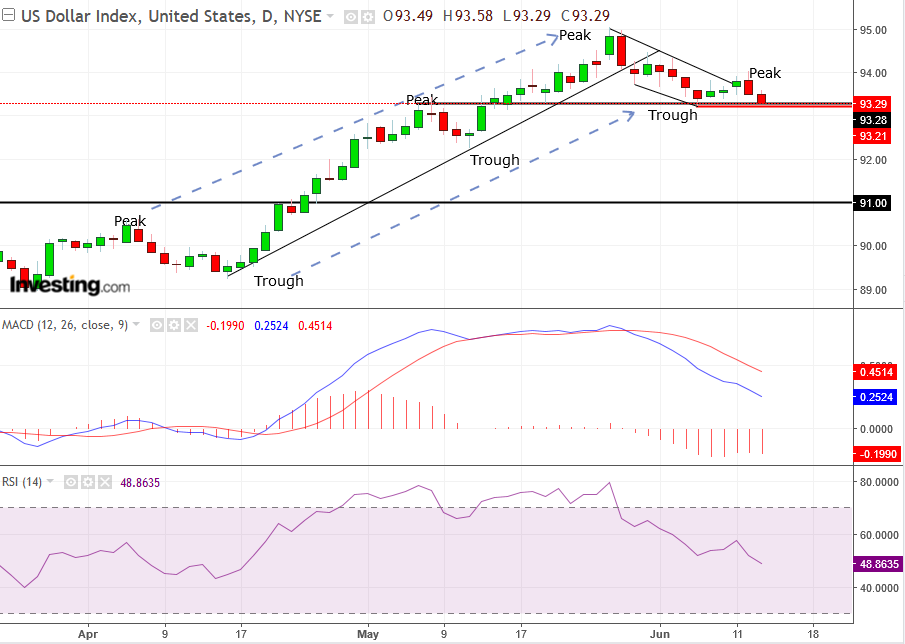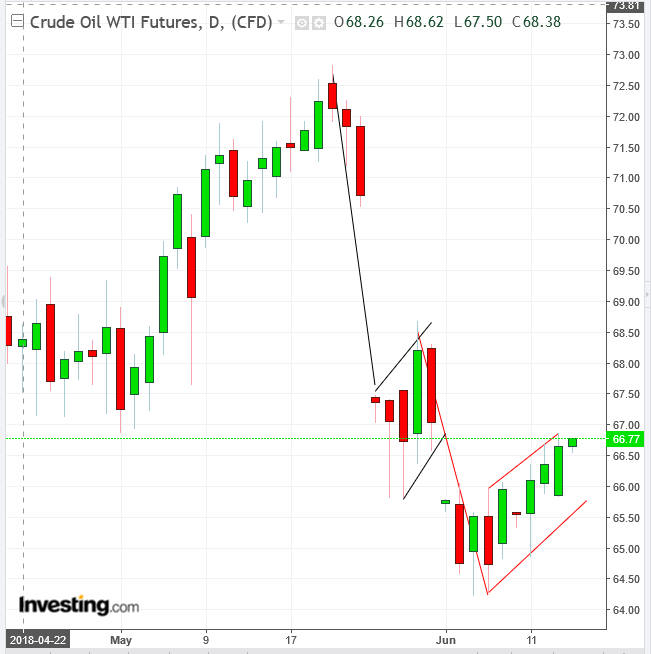-
Chinese industrial production, retail sales and infrastructure spending hit multi-year lows
-
Will the US expansionary trend remain intact, supporting the Fed's higher outlook for tightening?
-
US yield curve shrinks to the flattest level since 2007, raising a red flag for potential economic downturn
- Dollar continues slipping
Key Events
Following a slump this morning in Asian markets, stocks in Europe gapped down in Thursday's early trade, with the pan-European STOXX 600 taking its cue from the downward move seen in the MSCI Asia Pacific Index. US futures on the S&P 500, Dow and NASDAQ 100 also pointed lower, suggesting the equity retreat may be poised to spill over onto the US session.
The across-the-board selloff during the Asian session came after several sets of data confirmed that China’s growth decelerated to multi-decade lows, as the PBoC decided to keep rates on hold after the Fed hike. Investors promptly rotated out of equities and into bonds, driving US yields lower. The yield on 10-year Treasurys had once again crossed the key 3.00 percent level yesterday, while today's climb is weighing down on the dollar.
The widespread risk-off sentiment also boosted the yen for a second day, which in turn weighed on Japanese shares, which are broadly reliant on exports. The TOPIX slipped 0.9 lower, closing at the bottom of the session.
Ironically, after key Chinese economic indicators including retail sales and industrial production came in significantly lower than expected this morning, China’s Shanghai Composite still outperformed among Asian benchmarks with a limited 0.35 percent decline, thanks to an earlier 0.5 percent advance. Technically, it found support again above the 3,000 psychological level, which has proved to be a line of demand all year. Hong Kong’s Hang Seng dipped 1.3 percent intraday, but then closed 0.93 percent in negative territory.
South Korea’s KOSPI underperformed regional peers and ended at the bottom of the session, 1.8 percent in the red, for an aggregate two-day 1.9 percent decline. The won continued to strengthen.
Australia’s S&P/ASX 200 turned out to be today's regional winner, retreating just 0.1 percent, for a total two-day decline of 0.6 percent.
Global Financial Affairs
Today's losses follow a lackluster performance yesterday for US markets, as the Fed not only pressed ahead with an expected interest rate hike, but also signaled a steeper path to further tightening.

The S&P 500 confirmed a resistance line since late February, with an engulfing bearish pattern that wiped out more than two days of gains, thereby also confirming the resistance of Tuesday’s shooting star.
On the heels of yesterday's disappointing US session, this morning's releases from China indicate its economy seems to be quickly losing steam: along with slowing industrial production and weaker retail sales, fixed asset investment also came in at either multi-year or all-time record lows. Infrastructure spending, via fixed asset investment, dropped to 6.1 percent year-on-year, falling short of the 7 percent expectation, posting the slowest pace of expansion since the National Bureau of Statistics started reporting the data in 1996.
Retail sales in May ticked 8.5 percent higher, nearly 1 percent below April's figure and missing the 9.6 percent estimate. It was the weakest performance for this metric in 15 years. Finally, Industrial output increased 6.8 percent, also missing the 6.9 percent forecast and slowing to a 22-year low.
The rapidly emerging picture of a slowing Chinese economy follows the government's crackdown on high risk bank leverage over the last few years, which has led to higher costs of borrowing for both businesses and consumers.
The stack of negative economic data also stayed the hand of the People's Bank of China, which left borrowing costs for interbank loans unchanged today. Markets were expecting the PBoC to pursue its longstanding policy of keeping the spread between US and Chinese yields stable in order to avert sharp declines in the yuan and hasty capital outflows—which have often plagued the domestic economy.
The sudden shift in the outlook for China’s economic growth comes about a month after we indicated something like this could be developing.
Germany also disappointed expectations, albeit in late May, posting its weakest quarterly economic growth in a year: German GDP grew at a 0.3 percent pace—half the figure of the prior quarter—mainly because of a slowdown in trade momentum. The deceleration of the biggest European economy underscores an increasingly evident trend that sees Europe as the weakest link in the synchronized global growth story—in stark contrast to mid-last year, when Europe replaced China as the leader of global growth.
With mounting signs that both the European and Chinese economies are slowing, can the US hold on to its expansionary trend, or will it be dragged lower? Statements from the FOMC press conference yesterday signaled that US policymakers are betting on ongoing growth. Fed Chair Jerome Powell said the US economy is in “great shape,” warranting additional monetary policy tightening.

However, an important market indicator is telling a different story: the US yield curve flattened after the Fed hinted at a fourth hike this year, with the gap between the 2-year and 10-year rates narrowing the most since 2007. A spread flattening may lead to an inversion in the yield curve, which means shorter term notes pay a higher yield than longer term notes. This in turn becomes a key indicator for an upcoming recession.
The emerging divergence among global economies may influence narratives in another area as well. Considering the political agenda pushed forward by US President Donald Trump has so far pivoted around trade, and given Trump's diplomatic combativeness, it seems likely he might leverage the resilience of the US economy against shrinking growth in both Europe and China to argue the US holds the upper hand at the negotiating table.
As well, the Trump administration is still considering whether to follow through on its plans for $50 billion-worth of tariffs on Chinese goods, after some conciliatory statements recently released by both Chinese and the US officials failed to translate into any concrete step forward.

Ironically, the dollar is sliding lower despite the Fed's surprise signal yesterday, of a fourth rate hike this year. It's possible tradersbelieve that the ongoing trade war risk will overshadow the benefits of a stronger-than-expected outlook for rates. They may also be pricing in indications that European policymakers will soon start tapering QE, which is expected to be announced later today at the ECB press conference.

WTI edged higher in the European session, following reports that China and India are looking to step up demand for US oil to counter possible price strategies from OPEC countries. Technically, the price is retesting the upper boundary of a second consecutive bearish rising flag.
Up Ahead
-
Stay tuned for the ECB’s rate decision today, in which investors are holding their breaths in anticipation of the possible end to its QE.
-
The BoJ meets for its monetary policy decision on Friday, in which it’s expected to keep the status quo, amid growing criticism.
Market Moves
Stocks
-
The STOXX Europe 600 sank 0.5, the largest decrease in two weeks.
-
Futures on the S&P 500 dipped 0.2 percent to the lowest level in more than a week.
-
The UK’s FTSE 100 decreased 0.6 percent to the lowest level in more than two weeks on the largest dip in more than a week.
-
Germany’s DAX gained 0.4 percent to the highest level in almost three weeks.
-
The MSCI Emerging Markets Index sank 1.1 percent to the lowest level in two weeks.
-
The MSCI Asia Pacific Index sank 1 percent to the lowest level in almost two weeks on the biggest dip in more than two weeks.
Currencies
-
The Dollar Index dipped 0.15 percent, a second day with an aggregate 0.45 loss.
-
The euro gained 0.2 percent to $1.1818, the strongest in a month.
-
The British pound increased 0.3 percent to $1.341, the strongest in a week on the largest increase in more than a week.
-
The Japanese yen rose 0.3 percent to 110.05 per dollar, the biggest advance in a week.
-
The Turkish lira jumped 0.3 percent to 4.6319 per dollar.
Bonds
-
The yield on 10-year Treasuries fell one basis point to 2.96 percent, the first retreat in a week.
-
Germany’s 10-year yield increased less than one basis point to 0.49 percent.
-
Britain’s 10-year yield gained one basis point to 1.369 percent.
-
Italy’s 10-year yield climbed three basis points to 2.837 percent.
Commodities
-
West Texas Intermediate crude was unchanged at $66.64 a barrel, the highest in two weeks.
-
Gold climbed 0.3 percent to $1,302.96 an ounce, the highest in three weeks on the largest increase in more than a week.
-
Brent crude fell 0.4 percent to $76.40 a barrel.
